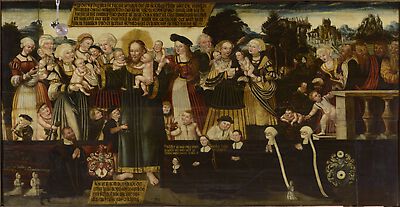- Attribution
- Follower of Lucas Cranach the Younger
Attribution
| Follower of Lucas Cranach the Younger | [Cat. Leipzig 2006, 125] |
- Production date
- after 1551
Production date
| after 1551 | [Cat. Leipzig 2006, 125] |
- Dimensions
- Dimensions of support: 124 x 171 cm
Dimensions
Dimensions of support: 124 x 171 cm
[Cat. Leipzig 2006, 125]
- Signature / Dating
None
- Inscriptions and Labels
-
top text block: 'Zu der Zeit brachten sie kindlin zu Jhesu, das ehr sie solt anriren aber die junger …
Inscriptions and Labels
Inscriptions, Badges:
- top text block:
'Zu der Zeit brachten sie kindlin zu Jhesu, das ehr sie solt anriren aber die junger be
draueten die so sie brachten. Do das Jhesus sahe vordros in und sprach zu in: last die
kindlin zu mir kummen und weret in nicht den solcher ist das himmelreich warlich
ich sage euch wer nicht das reich gottes nimpt wie ein kindlin der wirt nicht
hinein kummen und er hertzet sie und leget die hende auf sie und segenet sie.'
- bottom text block:
'Ess ist in gott vorscheide[n] der
erbar hans nopel. Auff 29. April des
- jars. got gebe ime und uns
allen eine frülige aufferstehung.'
- bottom left above the two children wearing shrouds:
'hans nopel seines alters 8 tag'
'[...] seines alters 14 tag'
'gerhart nopel seines alters 2 tag'
- to the right of Christ above and between the kneeling girls:
'Welcher ist umb unser sunde willen dahin
gegeben und umb unser gerechtigkeit
willen aufferwecket. Roma. 4.'
- bottom right, beneath the child wearing a shroud Unter dem Kind im Totenhemd:
'Anna nopel ires alters 5 tag'
[Cat. Leipzig 2006, 125]
- Owner
- Stadtgeschichtliches Museum, Leipzig
- Repository
- Stadtgeschichtliches Museum, Leipzig
- Location
- Leipzig
- CDA ID
- DE_SML_kK15
- FR (1978) Nr.
- FR-none
- Persistent Link
- https://lucascranach.org/en/DE_SML_kK15/
-
